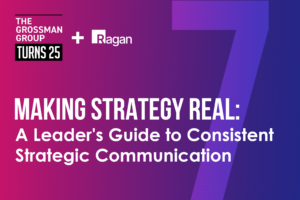Comms experts: Pulse surveys just the first step in prompting actionable employee engagement
Three industry leaders share how to make employees feel valued, heard and supported.

Internal comms pros know that bolstering your employee engagement strategy is about more than periodic listening surveys—it’s about generating genuine, actionable feedback from workers. Engagement is the backbone of a healthy company culture—but how do you get there?
In a recent Ragan Training video, “The Evolution of Employee Engagement: Communicating to a Hybrid Workforce,” three industry leaders address how to mindfully communicate with your remote or hybrid workforce.
For Sarah Plaster, now the senior director of change management and ESG comms with SAIC, prioritizing her employees’ needs during her 11 years with Aflac meant re-thinking the usual amount of paid time off and 9-to-5 working hours. After seeing the results of a yearly employee poll, the change that needed to be made was clear.
“When we looked at employee burnout, they just basically gave the feedback, ‘Could we please either have more flexible scheduling or more paid time off?’” Plaster recalls.
So Aflac adjusted its policies, granting employees more PTO and working to develop more flexible work schedules.
Anthony Bolton is senior manager of employee comms and events at Gulfstream Aerospace. He argues that the remote/hybrid nature of work has actually helped employees be more responsive to callouts for feedback.
Now, he says, “employees have more courage and agency to say exactly what’s on their minds.”
Gulfstream’s employee comms team saw more attendees at their virtual town halls than they had at the in-person events pre-pandemic—and the attendees were more engaged, too. They asked more questions and gave more feedback.
“We’d schedule a town hall for an hour, and it would end up going for 90 minutes,” Bolton says.
Greg Stortz, director of engagement with Interact, says the key to ongoing employee engagement isn’t in the actual feedback, but rather in what leaders choose to do with the information they receive from workers.
“We never, ever ask a question we’re not ready to answer or resolve; or to take that feedback and actually look at how we can use it to build a better workplace,” he says.
At the beginning of the pandemic, Stortz says, he received feedback that employees were loving the remote work setup. But then, things started to change. And what Interact workers wanted changed, too.
So Stortz and his team had to continue listening, as what benefited employees the most shifted from an all-remote work environment to a more hybrid setup.
Even in a time of “Zoom fatigue” and high work-related stress, employees do still want to feel heard, Stortz says—they just lose confidence when their feedback fails to gain traction.
Bolton echoes this sentiment: “If there’s been a history of no follow up, no action in response to the feedback from employees, they’re really just going to be like, ‘What’s the point?’”
So continue using those pulse surveys. Try something new with your company intranet, like combing the comments on a recent post to get a sense for employee sentiment you may not be seeing elsewhere.
Above all, these experts stress, it’s about what leaders do with the feedback they hear.
“In a job market where jobs are few and far between, companies can get away with not listening. But today, we’ve got to listen,” Plaster says. “The employers who are not listening? I think they will absolutely lose talent.”
How does your organization encourage—and act on—employee feedback? Will you continue to use pulse surveys in 2022?
See our full library of presentations and conference content on Ragan Training.







